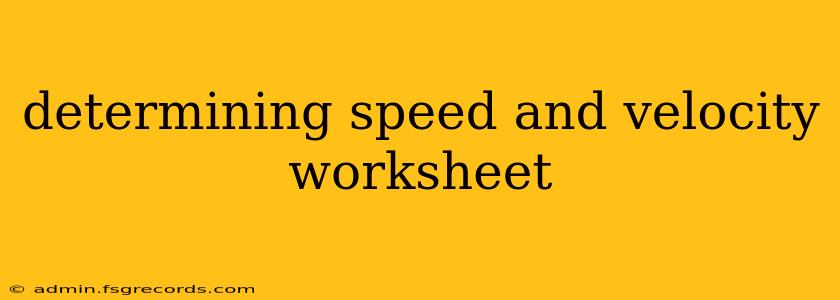Understanding the difference between speed and velocity is crucial in physics. While both measure how quickly an object changes its position, velocity also considers the direction of that change. This worksheet will help you solidify your understanding through a series of exercises.
What is Speed?
Speed is a scalar quantity, meaning it only has magnitude (size). It tells us how much distance is covered in a given amount of time. The formula for calculating average speed is:
Speed = Distance / Time
Where:
- Speed is measured in units like meters per second (m/s), kilometers per hour (km/h), or miles per hour (mph).
- Distance is the total length of the path traveled.
- Time is the duration of the travel.
What is Velocity?
Velocity is a vector quantity, possessing both magnitude and direction. It tells us how quickly an object changes its position and in what direction. The formula for calculating average velocity is similar to speed, but it considers displacement instead of distance:
Velocity = Displacement / Time
Where:
- Velocity is also measured in units like meters per second (m/s), kilometers per hour (km/h), or miles per hour (mph), but always includes a direction (e.g., 10 m/s North).
- Displacement is the shortest distance between the starting and ending points, considering direction. It's a vector quantity.
Practice Problems: Speed and Velocity
Let's work through some examples to clarify the differences. Remember to show your work and include units in your answers.
Section 1: Speed Calculations
-
Scenario: A car travels 150 kilometers in 3 hours. What is its average speed?
-
Scenario: A runner covers 100 meters in 12 seconds. Calculate their average speed.
-
Scenario: A train travels 450 miles at an average speed of 60 mph. How long does the journey take?
Section 2: Velocity Calculations
-
Scenario: A bird flies 200 meters due east in 40 seconds. What is its average velocity?
-
Scenario: A boat sails 5 kilometers due north, then 5 kilometers due south, returning to its starting point. The entire journey takes 1 hour. What is the boat's average velocity? (Consider the displacement.)
-
Scenario: A ball is thrown vertically upward. It reaches a maximum height of 15 meters and then falls back to the ground. The total time of flight is 6 seconds. What is the ball's average velocity for the entire flight?
Section 3: Comparing Speed and Velocity
-
Scenario: Explain why it's possible for an object to have a constant speed but a changing velocity. Provide a real-world example.
-
Scenario: Can an object have zero velocity but non-zero speed? Explain your answer.
Section 4: Challenge Problem
A cyclist rides 10 km East, then 5 km North, and finally 10 km West. The entire journey takes 1 hour.
- a) What is the total distance traveled?
- b) What is the cyclist's displacement?
- c) What is the cyclist's average speed?
- d) What is the cyclist's average velocity?
This worksheet provides a foundation for understanding speed and velocity. Remember that consistent practice is key to mastering these concepts. Good luck!

